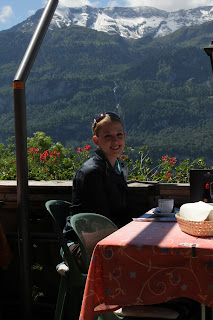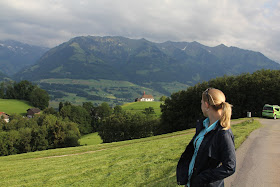While the views everywhere are fantastic, our hotel also had an amazing view. You can see the Jungfrau itself, a peak of 13,642 feet, from our room's balcony.
A sampling of the views from our hotel room balcony (above and below) - one at later in the afternoon, and one at 6:00 in the morning.
Here I am at one of the many restaurants we ate at with a birds-eye view of the mountains beyond. We started feeling pretty spoiled!
On Saturday, we visited Lucerne and Brienz, and just about everything in between. Lucerne is a romantic city, especially near Tower Bridge, the oldest surviving wooden bridge in Europe. The overall atmosphere is made even more nostalgic by the talented street musicians, and elegant white swans floating down the river.
Hard at work in Lucerne. The boat took off before I could finish my painting. Will have to put in a few more details later. :-)
Steve and I spent some time hunting down beautiful buildings and mountain peaks on our Alpine drives, sometimes driving up so high that we thought we might tip off the hillsides. This little gem of a chapel is something I would like to paint.
On our way back to the hotel from Lucerne, we stopped for dinner in Brienz. There is a walkway all along the north shore of the lake there, so Steve and I enjoyed a leasurely stroll.
Sunday morning, up bright and early and freezing my little fingers off to get in this pastel landscape. I wanted to capture the soft light, and unfortunately, it required getting up at 6:00 a.m. I did three paintings that day! (See below)
Another shot of my morning painting.
Sunday morning: Steve and I spent most of the day in the Lauterbrunnen valley (see the shot below). Above: our first stop was to visit Trummelbach Falls, incredible waterfalls that come down through the mountain. Lauterbrunnen is part of the larger Jungfrau Region and is one of the most spectacular places in Switzerland! The waterfalls cascade down cliffsides and into tumultuous rivers. The water, which is fed from mountain glaciers, is extremely pure. Steve and I had a taste when we refilled our water bottles directly from the river!
Lauterbrunnen Valley, view from our cable car headed to Murren.
Getting started on my second painting of the day. I set up on a hiking trail above the car-free town of Murren. Had we chosen to go up further, we could have ended up at Mount Schilthorn, where there is a revolving restaurant and an incredible view of the Jungfrau.
This was my favorite painting of the trip so far; with so much inspiration, it can be a bit overwhelming. This time I just had fun with it, and the sketch turned out great! For my artist friends: I have been working with a Guerrilla 9x12 pochade box, which mounts on a camera tripod and fits nicely in a large backpack. My panels are Raymar panels in either 8x8 or 9x12.
Steve and I stop for one more picture before heading back for the day.
Relaxing with a bottle of the house wine on our hotel balcony. That's when the sun started setting and the scene before me was this: ...
How could any artist resist painting this amazing beauty?! I set up one more time, and ended up doing a quick sketch of 1/2 an hour. The light changed rapidly, but it every minute of the painting was exhilerating.
Here is a partial line-up of my paintings from this trip. So far I've done a total of ten paintings. Below are two more from yesterday, which was our last day in Switzerland.
A lone tree in front of the mountains, in Grindelwald.
Later that afternoon: the clouds were beautiful; Steve and I drove around Lake Thun, and I ended up finding this great spot on the north side.
No trip to Switzerland would be complete without a picture of a cow wearing its cowbell. I'm thinking about getting one for my dog so I don't lose her on the mountainside... ha.
Well, this morning we left early and drove straight to Venice. We spent the afternoon exploring, and were very thankful for our street map in finding our way back to our hotel. No paintings today, but perhaps tomorrow. Until then, buona sera!
















































